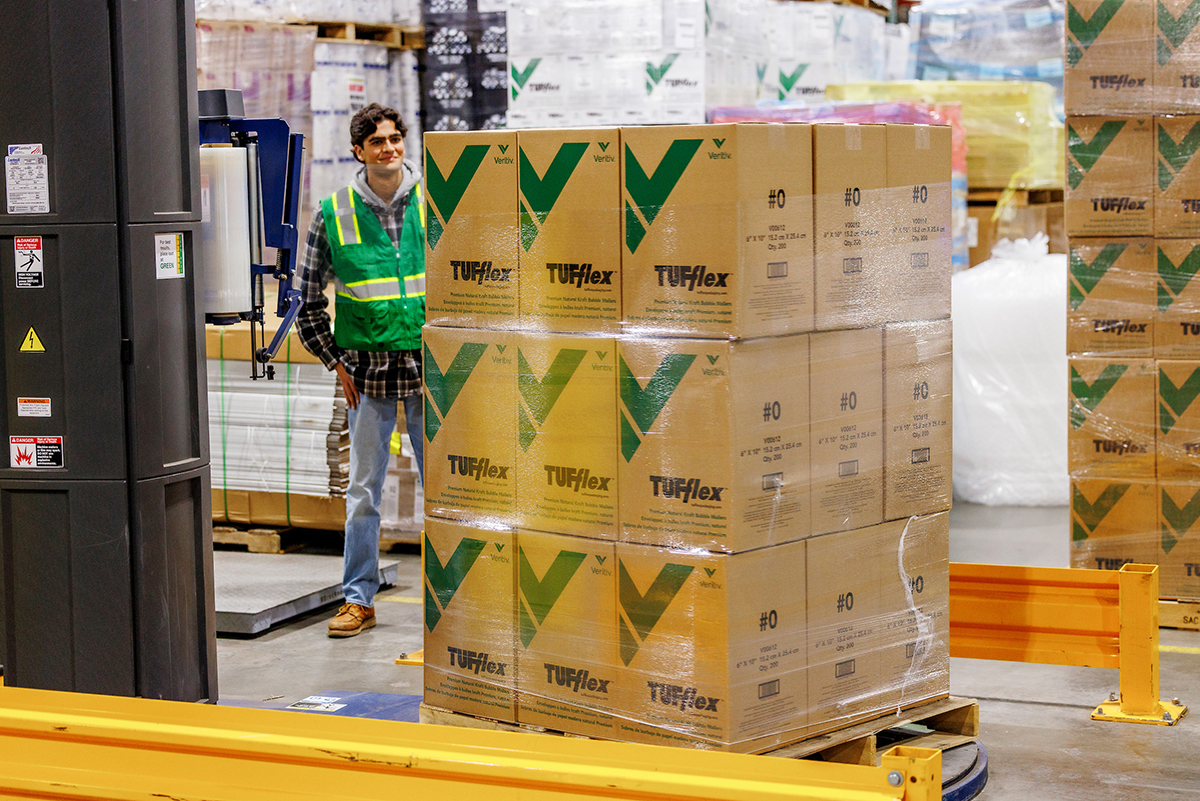Building a Circular Economy for Stretch Film
- Published: April 06, 2024

By Kristen Ream, Director of Sourcing, Veritiv
According to The Closed Loop Foundation, recycling rates for stretch film are estimated to be just 21 percent in the U.S.
As we have seen this year, companies have a renewed focus on sustainability but stretch film circularity continues to remain an underdeveloped market. Stretch film is an indispensable material for companies as it offers a range of benefits across different industries and applications including packaging, shipping, and storage. While many companies already use stretch film, the main question now is how can it become more sustainable?
Closing the circular economy gap for stretch film will take years to complete and requires a combined industry effort from companies across all industries. Organizations can introduce sustainable solutions by leveraging downgauging to ensure the correct amount of stretch film is being used, innovative materials, and partnering with leading industry experts.
Sustainable Choices
For some time, the most sustainable option for stretch film has been for companies to downgauge their stretch film by using high performing films at thinner gauges. This reduces the amount of plastic used which ultimately gets sent to landfills.
To help determine the right film for each wrapped pallet, organizations can leverage a load containment analysis process to determine the variables that may cause products to break, ultimately wasting material. An example is a Secure Wrap Analysis which can identify inefficiencies, uncover the root cause for damaged goods, and recommend the right stretch film so organizations can reduce product damage and losses, decrease total costs, introduce sustainability, and improve worker safety.
Innovative Materials
New solutions are now available in addition to conventional downgauging. This innovative solution has been providing customers who have already taken steps in downgauging additional sustainable opportunities.
Beyond its sustainable attributes, post-consumer recycled (PCR) films are versatile films that allow machine wrapping of products in a fast, secure, and timely manner. Machine stretch films available today can include up to 30 percent PCR without compromising performance.
PCR resin has been used in hand stretch film for many years, but it has not been until recently that manufacturers have introduced machinable PCR stretch film to the market. This highly engineered film had to withstand rigorous testing and development to ensure the introduction of recycled content would not compromise the integrity of the load being wrapped.
Companies that purchase and manufacture products containing PCR content have an obligation to develop products that provide a sustainable advantage, specifically the balance between a high-performance film with high recycled content and thin gauge. This combination contributes to both a circular economy and reduction of waste to the landfill.
Plastic can be recycled and repurposed to use again in packaging. Stretch film made with 25-30% post-consumer resin (PCR) and up to 80% total recycled content is available for select products.
PCR stretch films are helping build a circular economy by melting down and reusing plastic that would otherwise be in a landfill and not recycled. The film has been providing businesses who have already taken steps in downgauging additional sustainable opportunities. Furthermore, this film protects packaging to deliver enduring performance, maximize efficiency, and provide unmatched value and performance.
Partnerships
Building a circular economy for stretch film requires manufacturers, suppliers, end-users, and recycling companies to work together for the next frontier of sustainability.
Find a packaging partner that also invests in green energy sources and focuses on investing in better technology to reuse and recover materials. It is essential to hitting an organization’s targets and sustainability goals and in the pursuit of a circular economy.
Ask questions of packaging partners. A benefit of working with a packaging partner who also offers packaging design and testing could be a custom sustainable packaging solution to reach your unique product and company goals. They can provide solutions that meet the many laws and regulations by state and country.
It is an easier, simpler process when a business chooses the right partner who understands packaging pain points and can pivot to create customizable solutions designed around these elements. By working with packaging providers to determine the best sustainable stretch film solution, your organization will be one step closer to reaching your sustainability goals.
Looking Ahead
Stretch film is an essential tool that nearly every business that ships products needs in their tool belt because it gets the job done, but only when done correctly. Companies seeking sustainable alternatives must always consider the film’s efficacy to minimize product breakage, damage, and loss – which can contribute to even more waste. Whether you are pallet wrapping, securing goods in place, or protecting items during the shipping process, correctly using stretch film saves time and resources.
By understanding how to leverage downgauging practices, prioritizing innovation in film materials, such as PCR film, and partnering with industry experts who focus on circular economies, companies will be able to secure a more sustainable future for stretch film.
ABOUT THE AUTHOR
Kristen Ream is the Director of Sourcing at Veritiv. Joining the team in 2012, her role is dedicated on working with suppliers to get the right products to Veritiv customers across many industries. Recently, she also helped to lead the charge for every salesperson to be trained in conducting Secure Wrap Analysis, Veritiv’s load containment assessment. Her team helps Veritiv to better understand how effectively customers are using stretch film and find ways to use film more sustainably, effectively, and cost-efficiently.




